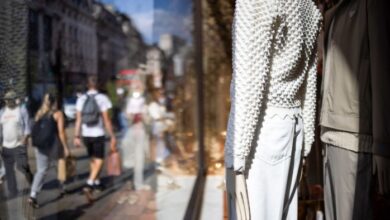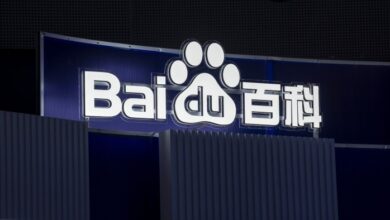China rolls out stimulus to boost growth
China has rolled out a series of stimulus measures including cutting benchmark interest rates as Beijing grapples with a slowdown in the world’s second-largest economy.
In a rare public press conference on Tuesday, People’s Bank of China also announced government funding to boost the stock market and support share buybacks, as well as more support for the struggling real estate sector.
With economists skeptical about whether China will achieve the government’s full-year growth target of 5%, PBoC governor Pan Gongsheng said, saying the measures were aimed at “supporting the stable growth of the Chinese economy” and “promoting a moderate recovery in prices”.
The package of measures sent China’s CSI 300 index of Shanghai- and Shenzhen-listed stocks up 4.3 percent on Tuesday, its best day since July 2020, although it is still down 1 percent year-to-date. Hong Kong’s Hang Seng index rose 4 percent, led by mainland Chinese companies listed in the territory.
In Europe, the Stoxx Europe 600 index rose 0.8 percent in early trading, with shares of luxury groups such as LVMH, Kering and Hermès all rising on hopes that the economic stimulus package will boost Chinese consumer spending.
Commodity markets rose on the news, with iron ore posting its biggest daily gain in more than a year, rising 4 percent on the Dalian spot market. On the London Metal Exchange, copper jumped 2.2 percent and aluminum rose 2.4 percent.
Pan said the PBoC would cut the short-term seven-day reverse repo rate, the central bank’s main policy rate, to 1.5% from 1.7%.
The PBoC will also cut the reserve requirement ratio, the amount of reserves that lenders must hold, by 0.5 percentage point, he said, signaling the possibility of another 0.25 to 0.5 percentage point cut this year. He said the RRR cut would inject 1 trillion yuan ($142 billion) of liquidity into the banking system.
“The rare simultaneous cuts in policy rates and RRRs, the relatively large size of the cuts and the unusual guidance on further policy easing suggest policymakers’ growing concerns about growth headwinds,” Goldman Sachs said in a note.
But economists say with household borrowing demand remaining low, the government will probably need more direct fiscal spending to improve growth prospects.
“Fiscal stimulus should be the top priority,” said Ting Lu, chief China economist at Nomura.
China’s economic growth has slowed in recent months as a prolonged downturn in the real estate sector has hit consumer sentiment.
Economists have cut their growth forecasts below the government’s official target of around 5 percent for 2024 as deflationary forces persist, with producer prices falling since last year.
Robust shipments of electric vehicles, batteries and other goods cannot fully compensate for a weak domestic economy.
“China’s economy is recovering and the monetary policies our bank has introduced this time will help support the real economy, encourage spending and investment, and create a stable foundation for the exchange rate,” Pan said.
The central bank chief was joined by Li Yunze, director of the State Administration of Financial Regulation, the new financial sector regulator, and Wu Qing, chairman of the China Securities Regulatory Commission, the market watchdog.
Officials have announced a 500 billion yuan fund to help brokerages, insurers and funds buy shares. The PBoC will also provide 300 billion yuan to help companies carry out share buybacks.
“A new round of economic stimulus is definitely positive,” said Liu Chang, a macro economist at BNP Paribas Asset Management.
But with weak economic momentum heading into the fourth quarter, officials need to act “very quickly in the coming weeks to implement additional measures if they want to hit the 5 percent target,” Liu said. “We think there is still a worrying lack of urgency behind their rhetoric on stimulus measures.”
The PBoC’s cut comes after the U.S. Federal Reserve last week cut its benchmark interest rate by half a percentage point. The Fed’s move narrowed the gap between U.S. rates and those of other major central banks, easing pressure on foreign currencies and giving institutions, including the PBoC, more room to maneuver.
In other measures, the PBoC has lowered the down payment requirement for second homes from 25 percent to 15 percent. Second properties have been subject to tougher conditions to curb property speculation, previously a focus of President Xi Jinping.
The central bank also said it would improve the terms of a program in which it would provide 300 billion yuan to local government-owned enterprises to help them buy unsold inventory from property developers.
But the central bank stopped short of expanding the program, amid signs it had struggling to gain traction.
Economists say reducing China’s huge housing inventory is crucial to restoring confidence and boosting domestic consumption.
NFRA’s Li said regulators also plan to recapitalize China’s largest commercial banks, whose margins and profit margins have been eroded by fee cuts and interest rate cuts.
To improve the capacity to “operate and develop stably, and at the same time better promote the role as the main force serving the real economy… the state plans to increase the core tier-one capital of six major commercial banks,” Mr. Ly said.
He did not give further details, but the core tier one capital adequacy ratio of China’s biggest banks was above the 8.5% requirement as of the end of June.




